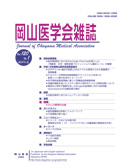

Journal of Okayama Medical Association
Published by Okayama Medical Association<Availability>
Full-text articles are available 3 years after publication.
Permalink : http://escholarship.lib.okayama-u.ac.jp/17652
Glutamate Dehydrogenase in Hepatobiliary Diseases Part 1. Clinical Significanse of Serum Glutamate Dehydrogenase in Hepatobiliary Diseases
Kitada, Shingo
Published Date
1971-06-30
Abstract
The activities of Glutamate dehydrogenase (GLD) in sera obtained from 21 of healthy individuals as well as 143 of patients (317 of determinations) with hepatobiliary diseases were measured according to the modified technique of Olson. The serum levels of the enzyme were also examined in reference to the histological findings of the liver and jaundice. The results obtained were as follows. 1) The GLD activities in the sera obtained from healthy individuals ranged from zero to 85.2 units. 2) The serum levels of GLD increased markedly in acute hepatitis with jaundice, intrahepatic cholestasis, cancer of the liver and obstructive jaundice, whereas the activity showed moderate rise in the convalescence of acute hepatitis, chronic hepatitis and liver cirrhosis. 3) The marked increase of the serum GLD in obstructive jaundice, intrahepatic cholestasis and cancer of the liver was not accompanied by a proportional increment of the serum transaminases (GOT and GPT). 4) In acute hepatitis and liver cirrhosis there was a close correlation between an increase of the serum GLD and an intensity of necrotic changes of the liver cells. Further more, the serum levels of GLD in liver cirrhosis were related to an extent of the distorted lobular reconstruction. 5) About 79% of the determinations in which the GLD/GPT ratio was more than 1.5 included exclusively intrahepatic cholestasis and extrahepatic jaundice. The remaining 21% comprised liver cirrhosis with abnormal zinc turbidity reaction. Thus, it would be reasonable to conclude that a new criteria (GLD/GPT>1.5 and normal zinc turbibity reaction) would be a useful diagnostic aid for obstructive hepatobiliary diseases.
ISSN
0030-1558
NCID
AN00032489
